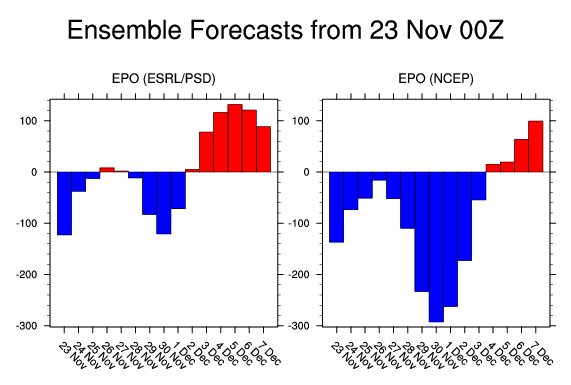Some of the synoptic patterns similar to that shown on the long-range guidance have seen a fairly significant cold shot before the pattern moderated. In my opinion, the 12/3-10 timeframe will likely feature a cold shot that could send the coldest temperature into the 22°-27° range from Washington, DC (DCA) to Boston. There is a chance that Boston might see a sub-20° low. Several sub-40° highs are likely in each of these cities. Cities such as Toronto and Burlington will likely experience at least a single-digit low with one or more days featuring highs below 32°. Moreover, some of the aforementioned synoptic patterns featured modest accumulations of snow in such cities as New York, Boston, Burlington, and Toronto, not to mention the Great Lakes cities including Detroit and Chicago.
Beyond the timeframe, major questions lurk as to whether a dramatic pattern change to warmer lies ahead. Historic experience with a number of notable La Niña winters would suggest that such a pattern change could take place.
If one examines the latest EPO forecast, there are hints of a shift to a milder pattern, as the EPO is progged to rise to positive levels.

However, some guidance points to a negative NAO and significant guidance still suggests a positive PNA. Hence, there is a chance that warming is delayed, particularly across New England.
In the longer-range, the ensemble guidance hints at the large pool of cold air that has covered much of Canada to be reduced. Whether or not this is will prove to be a hint of things to come remains to be seen.
For now, it appears that Winter 2007-08 will get off to a robust start in the East. But can the cold be sustained? That will be an issue that takes on added importance down the road, as a cold December during moderate or strong La Niña winters has often telegraphed a cooler than normal winter. On the other hand, a warm December has often signaled what became a warmer than normal winter.
Average Regional Temperature Anomalies (12/3-10):
Northeast: Below normal
Mid-Atlantic: Below normal
Southeast: Near normal
Great Lakes: Below normal
Northern Plains: Much below normal to below normal
Central Plains: Below normal
Southern Plains: Somewhat below normal to near normal
Pacific Northwest: Near normal to somewhat above normal
Southwest/Rest of West Coast: Above normal
 The posts in this forum are NOT official forecast and should not be used as such. They are just the opinion of the poster and may or may not be backed by sound meteorological data. They are NOT endorsed by any professional institution or
The posts in this forum are NOT official forecast and should not be used as such. They are just the opinion of the poster and may or may not be backed by sound meteorological data. They are NOT endorsed by any professional institution or 











